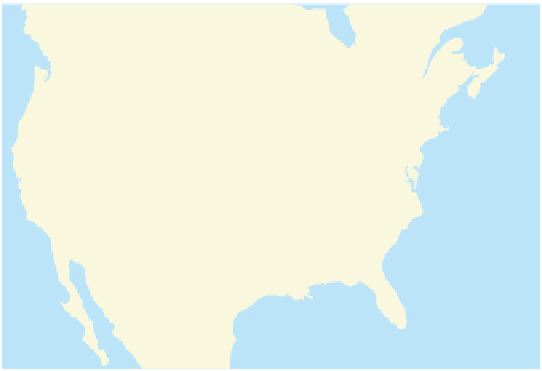Geoscience Reference
In-Depth Information
Formation of a Midlatitude Cyclone
We can now examine how the development of midlatitude cy-
clones occurs in an animated way by viewing the animation
Formation of a Midlatitude Cyclone
. This module allows you
to see the process of cyclogenesis in motion. Figure 8.9 is the
foundation of this animation. As you watch the animation, follow
how an initial kink in the atmosphere evolves into a mature cy-
clone that spins counterclockwise in the Northern Hemisphere.
This animation will help you better understand how these sys-
tems and associated processes cause highly variable weather
when they migrate through a region. Once you have completed
the animation, be sure to answer the questions at the end of the
module to test your understanding of this concept.
Now let's move on in our hypothetical sequence of
cyclonic evolution to Day 2 (Figure 8.11b). Two important
things are seen in this diagram. First, notice that the cold
front is beginning to overtake the warm front, as you might
have predicted. As a result, the temperature in Louisiana and
Arkansas, which had been warm the previous day due to
southerly airflow, is now colder because the winds are now
northwesterly. Second, the center of the system has migrated
slightly to the northeast along with the wave in the jet stream.
Eastward migration continues into Day 3 (Figure 8.11c), with
the onset of the occluded stage as the system moves into the
northeastern part of the country.
Canada
Motion along jet stream
Motion along jet stream
cP air
Canada
Northwest
winds
L
L
IN
IN
Warm front
Warm
sector,
mT air
Atlantic
Ocean
Motion of
warm front
OK
AR
OK
AR
TX
LA
Atlantic
Ocean
TX
LA
Cold front
Motion of cold front
Gulf of Mexico
Gulf of Mexico
(a) Day 1, open stage
(b) Day 2, cold front overtaking warm front
Motion along jet stream
Canada
Motion
of warm
front
L
IN
AR
OK
TX
LA
Atlantic
Ocean
Motion of
cold front
Figure 8.11 Evolution and migration of a cyclone.
Midlati-
tude cyclones migrate from west to east as they spin counter-
clockwise and evolve from initial formation, through the mature
stage, and into the occluded stage.
Gulf of Mexico
(c) Day 3, start of occluded stage



































































































































































































































































































































































































